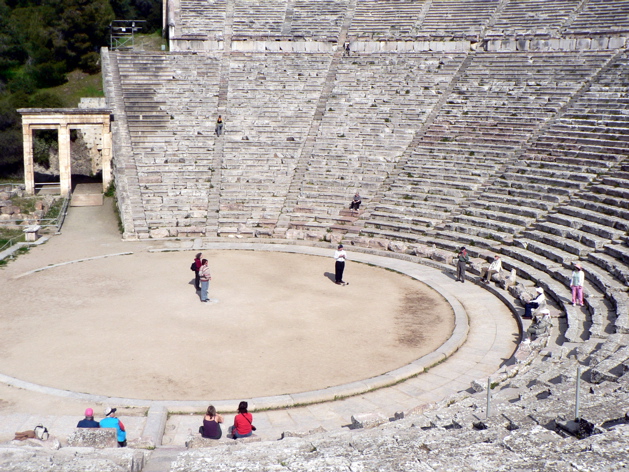<--Previous Up Next-->

P1060978.JPG
Epidaurus, Greece: theatre for music & poetry contests
Epidaurus
The Ancient theatre of Epidaurus belonged to the sanctuary of Asclepios, the God of healing. In his honor, sanctuaries, known as Asclepieia, were founded throughout Greece and parts of Turkey. This sanctuary prospered in the 4th c BC and continued to function with one or two interruptions until the 4th c AD, when, along with other shrines in Greece, it was closed by decree of the Emperor Theodosius. The severe earthquakes of 522 and 551 AD completed its ruin.
Excavation began in 1879 under the direction of P. Kavadias and was completed in 1951 by the French School of Archeeology. One the slopes of Mt. Kynortion lies one of the best known and best preserved of all ancient theatres, where performances are still given in the summer. Its superb acoustics reveal that the ancients knew well how to make the most of the morphology of a site when building a theatre. It was built in the early 3rd c BC by Polycleitus the Younger. In its original design, there was a circular orchestra, the only one to have survived unaltered from antiquity. At the center stood an altar. The seating capacity at that time was 6,200. In the 2nd c BC alterations were made to double the capacity by accommodating a further 6,100 spectators. The front seats were reserved for people of importance, and hence not just benches, but were fashioned into throne-like seats. In the main area there were two rooms on either side of the theatre with a row of small Ionian columns marking the outer edge of the facade. Each passage way was adorned by a stately monumental gate, adding allure to the whole structure.
To the north lies the sanctuary where only some remains are to be found. The sanctuary consisted of a gymnasium, bath house, palaestra, stoas, library, temples to various gods and goddesses of which the most important was the temple of Asclepios. An inscription of 380 BC informs us that it was of Doric style with 26 columns.
The cella housed the statue of Asclepios. It was decorated in gold and ivory and represented the God seated on a throne, one hand clasping a staff, the other resting on the head of a serpent, and a dog at his feet.
Near to the temple stood the Tholos — the Round House of Pausanias. Again, this was the work of Polycleitos the Younger. This circular building had an exterior colonnade of 26 Doric style columns and another interior colonnade of 14 Corinthian columns whose capitals are considered amongst the most beautiful. A richly ornamented door opened into a cellar, whose walls and ceiling were paneled in marble and decorated with sculptured blossoms. Below the cellar was a crypt. The purpose of the Tholos, however, remains obscure. It has been interpreted as a center for the practice of secret rites, a chapter house for priests, or a snake pit. The snake sheds its skin once a year thus renewing and revitalizing its body.
Working on this theme, patients entered the sanctuary to cleanse their minds and bodies in a healing process. The sick hoping for a cure, believed that the appropriate treatment would be revealed to them through dreams or by some other divine act. They would sleep in the Abaton or Enkoimetrion, a colonnade about 70 meters long. The dying were not allowed in, because if they should die within the sanctuary it would ruin the reputation of the God Asclepios. The majority of the patients had psychological disorders. The sanctuary kept the minds occupied through entertainment. The Gymnasium was not just for physical activities, but also included hours of medication. There was ablibrary for reading and studying. The baths contained relaxing and soothing mineral extracts.
The theatre gave performances which were held during the day until sundown, so at the end of the patients’ day they would return to their sleeping quarters quite exhausted but mentally much healthier.
